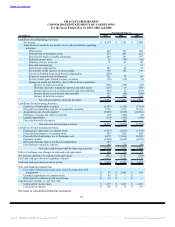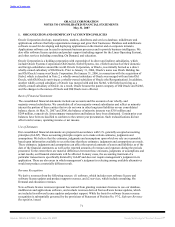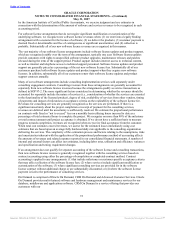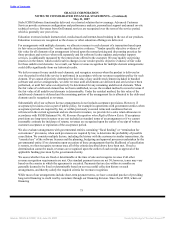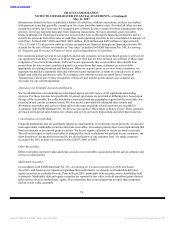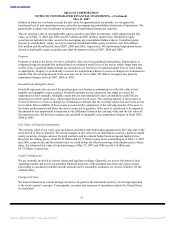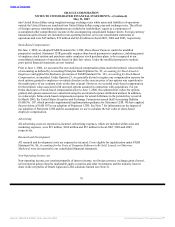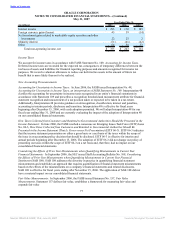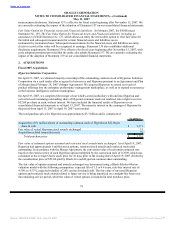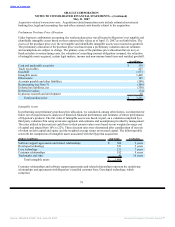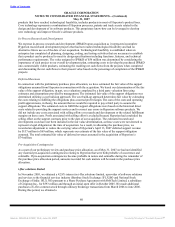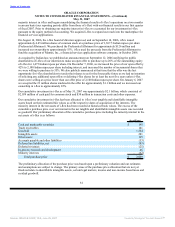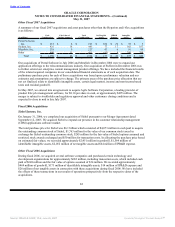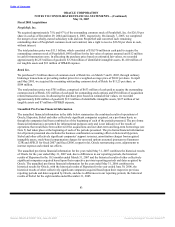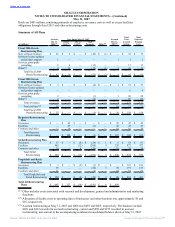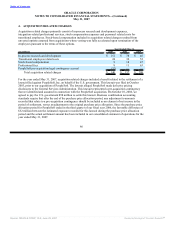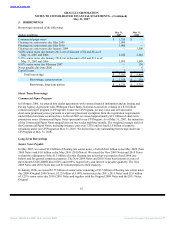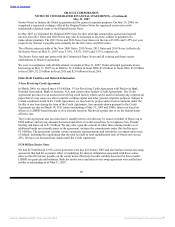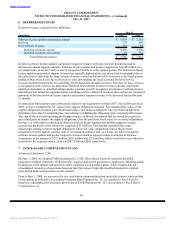Oracle 2006 Annual Report Download - page 86
Download and view the complete annual report
Please find page 86 of the 2006 Oracle annual report below. You can navigate through the pages in the report by either clicking on the pages listed below, or by using the keyword search tool below to find specific information within the annual report.
Table of Contents
ORACLE CORPORATION
NOTES TO CONSOLIDATED FINANCIAL STATEMENTS—(Continued)
May 31, 2007
products that have reached technological feasibility, includes products in most of Hyperion’s product lines.
Core technology represents a combination of Hyperion processes, patents and trade secrets related to the
design and development of its software products. This proprietary know-how can be leveraged to develop
new technology and improve Oracle’s software products.
In-Process Research and Development
We expense in-process research and development (IPR&D) upon acquisition as it represents incomplete
Hyperion research and development projects that had not reached technological feasibility and had no
alternative future use as of the date of our acquisition. Technological feasibility is established when an
enterprise has completed all planning, designing, coding, and testing activities that are necessary to establish
that a product can be produced to meet its design specifications including functions, features, and technical
performance requirements. The value assigned to IPR&D of $56 million was determined by considering the
importance of each project to our overall development plan, estimating costs to develop the purchased IPR&D
into commercially viable products, estimating the resulting net cash flows from the projects when completed
and discounting the net cash flows to their present value based on the percentage of completion of the IPR&D
projects.
Deferred Revenues
In connection with the preliminary purchase price allocation, we have estimated the fair value of the support
obligations assumed from Hyperion in connection with the acquisition. We based our determination of the fair
value of the support obligation, in part, on a valuation completed by a third party valuation firm using
estimates and assumptions provided by management. The estimated fair value of the support obligations was
determined utilizing a cost build-up approach. The cost build-up approach determines fair value by estimating
the costs relating to fulfilling the obligations plus a normal profit margin. The sum of the costs and operating
profit approximates, in theory, the amount that we would be required to pay a third party to assume the
support obligations. The estimated costs to fulfill the support obligations were based on the historical direct
costs related to providing the support services and to correct any errors in Hyperion software products. We
did not include any costs associated with selling efforts or research and development or the related fulfillment
margins on these costs. Profit associated with selling effort is excluded because Hyperion had concluded the
selling effort on the support contracts prior to the date of our acquisition. The estimated research and
development costs have not been included in the fair value determination, as these costs were not deemed to
represent a legal obligation at the time of acquisition. As a result, in allocating the purchase price, we
recorded an adjustment to reduce the carrying value of Hyperion’s April 13, 2007 deferred support revenue
by $137 million to $69 million, which represents our estimate of the fair value of the support obligation
assumed. The total estimated fair value of deferred revenues assumed in the acquisition of Hyperion is
$74 million.
Pre-Acquisition Contingencies
As a part of our preliminary review and purchase price allocation, as of May 31, 2007 we had not identified
any material pre-acquisition contingencies relating to Hyperion that were both probable of occurrence and
estimable. If pre-acquisition contingencies become probable in nature and estimable during the remainder of
the purchase price allocation period, amounts recorded for such matters will be made in the purchase price
allocation.
i-flex solutions limited
In November 2005, we obtained a 42.8% interest in i-flex solutions limited, a provider of software solutions
and services to the financial services industry (Bombay Stock Exchange: IFLX.BO and National Stock
Exchange of India: IFLX.NS) pursuant to a Share Purchase Agreement with OrbiTech Limited, a subsidiary
of Citigroup Inc., for $593 million and through an initial open offer in October 2005. We made additional
purchases of i-flex common stock through ordinary brokerage transactions from March 2006 to June 2006.
During this period, we obtained a
80
Source: ORACLE CORP, 10-K, June 29, 2007 Powered by Morningstar® Document Research℠


